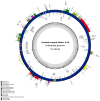Chloroplast Genome Sequence of Artemisia scoparia: Comparative Analyses and Screening of Mutational Hotspots
- PMID: 31698805
- PMCID: PMC6918244
- DOI: 10.3390/plants8110476
Chloroplast Genome Sequence of Artemisia scoparia: Comparative Analyses and Screening of Mutational Hotspots
Abstract
Artemisia L. is among the most diverse and medicinally important genera of the plant family Asteraceae. Discrepancies arise in the taxonomic classification of Artemisia due to the occurrence of multiple polyploidy events in separate lineages and its complex morphology. The discrepancies could be resolved by increasing the genomic resources. A. scoparia is one of the most medicinally important species in Artemisia. In this paper, we report the complete chloroplast genome sequence of Artemisia scoparia. The genome was 151,060 bp (base pairs), comprising a large single copy (82,834 bp) and small single copy (18,282 bp), separated by a pair of long inverted repeats (IRa and IRb: 24,972 bp each). We identified 114 unique genes, including four ribosomal RNAs, 30 transfer RNAs, and 80 protein-coding genes. We analysed the chloroplast genome features, including oligonucleotide repeats, microsatellites, amino acid frequencies, RNA editing sites, and codon usage. Transversion substitutions were twice as frequent as transition substitutions. Mutational hotspot loci included ccsA-ndhD, trnH-psbA, ndhG-ndhI, rps18-rpl20, and rps15-ycf1. These loci can be used to develop cost-effective and robust molecular markers for resolving the taxonomic discrepancies. The reconstructed phylogenetic tree supported previous findings of Artemisia as a monophyletic genus, sister to the genus Chrysanthemum, whereby A. scoparia appeared as sister to A. capillaris.
Keywords: Artemisia scoparia; Asteraceae; chloroplast genome; divergence region; phylogenetic; substitutions; taxonomic discrepancies.
Conflict of interest statement
There are no conflicts of interest between the authors.
Figures




References
-
- Hayat M.Q., Khan M.A., Ashraf M., Jabeen S. Ethnobotany of the genus Artemisia L. (Asteraceae) in Pakistan. Ethnobot. Res. Appl. 2009;7:147–162. doi: 10.17348/era.7.0.147-162. - DOI
-
- Valles J., Durant-McArthur E. Artemisia systematics and phylogeny: Cytogenetic and molecular insights; Proceedings of the Shrubland Ecosystem Genetics and Biodiversity; Provo, UT, USA. 13–15 June 2000; pp. 67–74.
LinkOut - more resources
Full Text Sources

